
Back to KehilaLinks Page--Wielkie Oczy | Jewish Gen Home Page | KehilaLinks Directory
The First Day
I left for Poland on Sunday morning April 22, 2001 and landed in
Krakow airport at 9:00 a.m. After a short visit with friends I rented a
car and traveled east toward Wielkie Oczy. I arrived at 6:00 p.m.
At the Wielkie Oczy cemetery I met Bogdan and 2 journalists. One of them from the Polish edition of National Geographic, and the second from Gazeta, the leading Polish newspaper. They explained to me that National Geographic (the Polish edition) is preparing a general article on Wielkie Oczy and that they also wanted to write about the cemetery. Additionally, Gazeta (the local Rzeszow edition) is preparing an article on the cemetery and our initiative. It was getting late, so we agreed to meet the next day at noon.
From Bogdan I also heard about the status of the work at the cemetery and saw the first results of these efforts. There were rains in this part of Poland in previous weeks and work has gone on more slowly than we had anticipated. There were also some bureaucratic obstacles and some differences between the priest and Bogdan about what type of fence to build, so they waited for my arrival to settle things. Now everything is on track, and the weather is good. I made decisions about the details of the fence, and the bureaucratic obstacles were broken. The fence should be ready by the end of May.
The Second Day
First I took the resolution from the Catholic Jewish Relations
Council sent by Rabbi Stadtmauer, including my Polish translation, and
I asked the local craftsman to make a wooden frame and to put it under
glass.
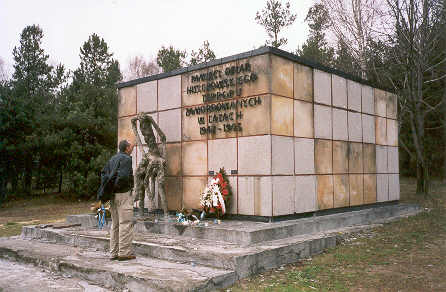 The Belzec Memorial
The Belzec Memorial
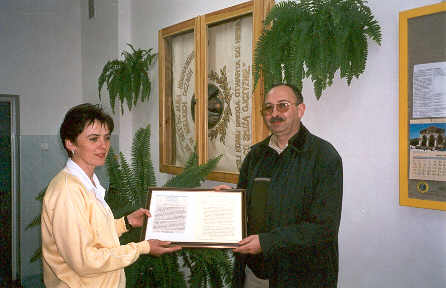
Jadwiga Palczynska, headmistress of the high school
in Wieklie Oczy receives a resolution from the Catholic Jewish
Relations Council of Northeast Queens (in New York City) that
acknowledes the humanitarian efforts of the students, their
teachers, religious and governmental officials and others for
their role in helping to restore the Jewish cemetery.
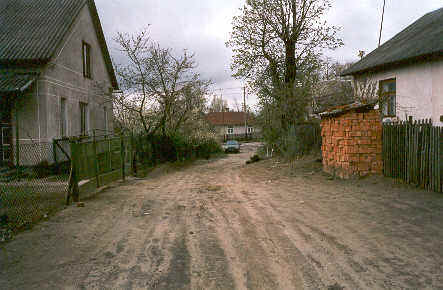 Krakowiec
Krakowiec

Jaworów
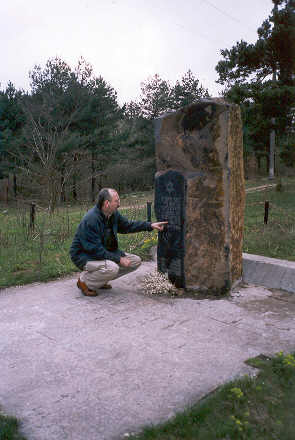
A memorial outside Jaworow where Jews
from Jaworówand Wielkie Oczy were shot.

In Wielkie Oczy...that's the synagogue in the
background.
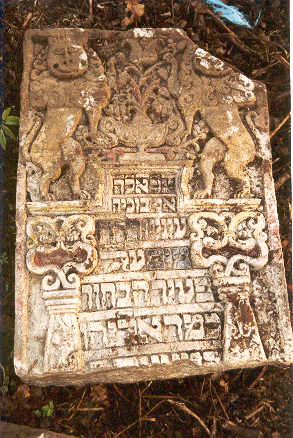
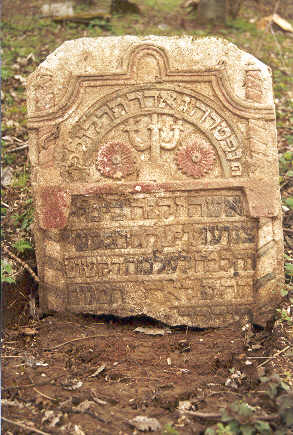
Headstones
On the way from Belzec to the meeting with the journalists I met the director of the Wielkie Oczy middle school (a pretty young woman named Jadwiga) and I gave her the resolution (see photo). She was very happy that people in the distant America know about her children cleaning the cemetery. I told her that we'd like to contribute something to the school.
The Third Day
I did some shopping in the Lubaczow
bookshop and then went to the school. The students received from
us the following books:
- Polish-English and English-Polish Dictionary (Collins)
- Polish-German and German Polish Dictionary
- Encyclopedia for Middle Schools Biology
- Encyclopedia for Middle Schools Literature
- Encyclopedia for Middle Schools History
- The Big Illustrated Atlas of the World
- The General Encyclopedia (in 7 Volumes)
All the students from the school were present. They asked some questions and were really happy to get all these books. I have a commitment from the school that in the coming years the cemetery will be cleaned by the students twice a year (spring and autumn).
In the afternoon I crossed the Ukrainian border—not an easy thing to do—and I went to Krakowiec (see photo) and to Jaworów (see photo), following the route that the Jews from Wielkie Oczy were forced to take in 1942.
In the Krakowiec photo you can see one of the streets of this village. I tried to talk to some older people, but they were frightened and told me that they knew nothing about Jews. In Jaworów I was lucky to meet a man named Ivan who told me where the Jaworów ghetto had once stood (see the photo on the left). The old houses of the ghetto don t exist anymore. They were destroyed during the War. Ivan took me into the forest 3 km from Jaworow, where Jews from Jaworów and Wielkie Oczy were shot by Germans (see photo).
It would be impossible to find this place without the help of a local, because to get there you almost have to cross a gate to the nearby camp of a Ukrainian Army armored division, and it is perhaps not the wisest thing to do in this part of the world. I returned to Poland after midnight, after 6 hours of checking by Ukrainian and Polish border guards.
The Fourth DayIn the morning I traveled through the countryside around Wielkie Oczy, including Zmijowiska, where I took some photographs. [Click here to see photographs of Zmijowiska] At noon I had a meeting with the director of the Lubaczow Regional Museum Mr. Kubrak and his staff. They have a little Judaica exhibition at the museum. We discussed possibilities of restoring the synagogue in Wielkie Oczy. The chances are poor because it would need much money. Without rich sponsors it would be impossible to restore. We decided we should start by meeting with the head of the local Wielkie Oczy authority, Mr Strojny. Within one hour a representative of the Museum (Mr. Mazur), Bogdan and I were in the office of Mr. Strojny. We were given assurances that the local authority would immediately finance an expert's report on the [scope of] work (and costs) needed for restoration of the roof, walls and foundations of the synagogue—the main problem is the roof. We decided also that the best thing (after the possible restoration of the synagogue) would be for it possibly to fulfill such three functions as: a village library, an internet-café for youth and a place for a Judaica exhibition of the region. All this is only a fantasy at this stage, but I think it's worth to try
.
Later, I had some conversations with local people who remember my family (see photo). And in the evening I invited Bogdan and his wife for a dinner. (Bogdan is a guest at home; he spends almost all the time in Wielkie Oczy, so I felt I should invite his wife and himself to a restaurant).
The Fifth Day
I spent all morning with a priest and read the parish chronicle to
find some facts about the history of Wielkie Oczy. I also gave him a
copy of the resolution of the Catholic Jewish Relations Council (the
photos are not ready yet). He was really affected. Afterwards, we (the
priest, Bogdan and I) left for the cemetery to settle differences
on the type of fence to be built. Bogdan showed me tens of pieces
of headstonestones that he found at local farms (see photo examples). He
still knows about other headstones, and they too will find their way to
the cemetery. In the afternoon I left for Krakow and I was there by 9:00
p.m.
The Sixth Day
I spent much time on research in Krakow libraries looking for materials
on Wielkie Oczy and I found a lot. Afternoon...some shopping.
The day with my Krakow friends...and then a flight home.
Some important information. The funds we had collected were not enough. All additional expenses were kindly donated by my brother (this in addition to his basic donation). Before my journey he offered to contribute this not insignificant sum for these expenses that were not included in the official cost estimation—including, for example, some money related to bringing back the headstones to the cemetery, some money that was used to help to break the bureaucratic obstacles, and so on. This money was also used to double the sum to the gift for the school.
Back to KehilaLinks Page--Wielkie Oczy | Jewish Gen Home Page | KehilaLinks Directory
Copyright © The Wielkie Oczy Foundation, Inc. All rights reserved.